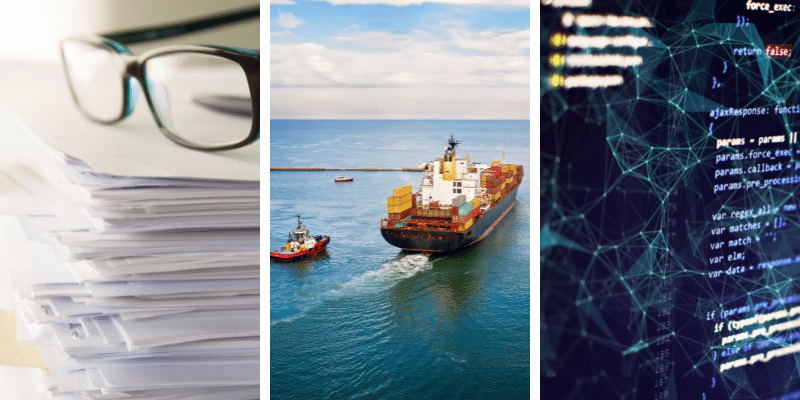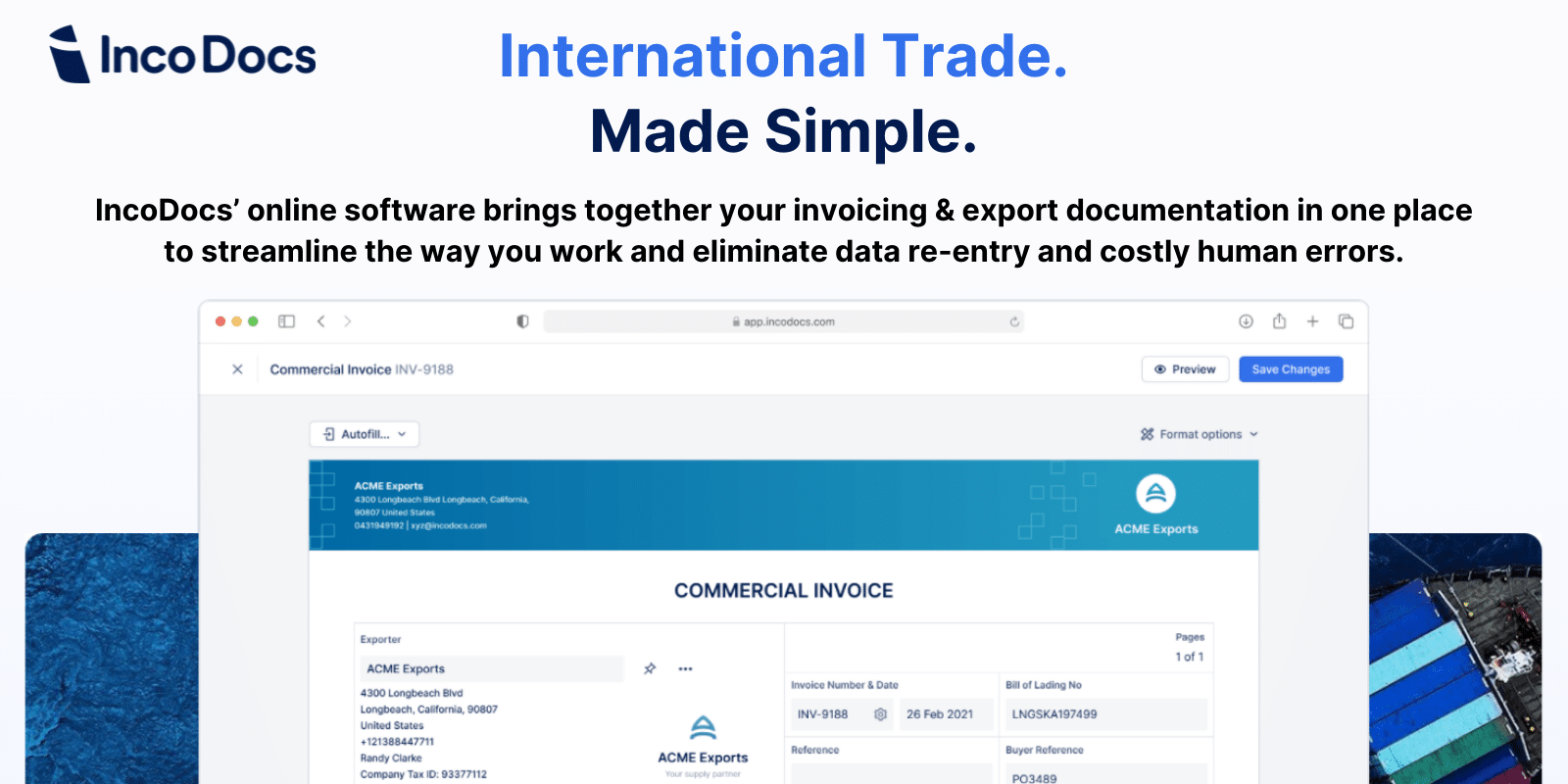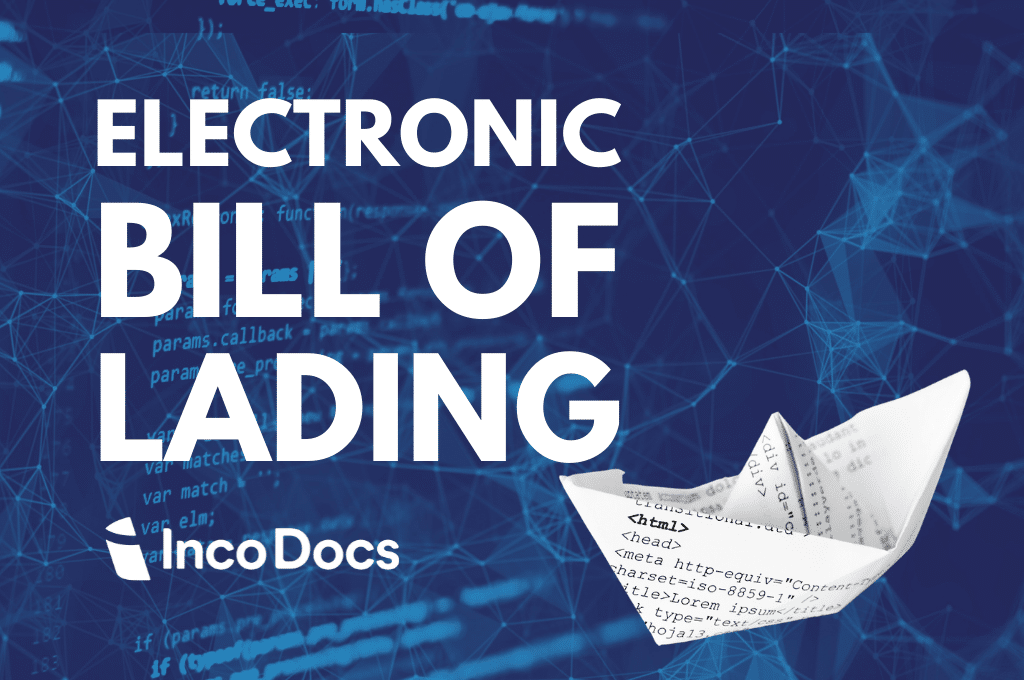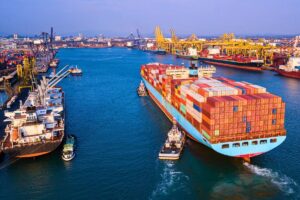New Electronic Bill of Lading Technology to Streamline Global Trade
Over the past few years there have been advancements in technology that have transformed the traditional paper Bill of Lading into an Electronic Bill Of Lading (eB/L) format. This new technology is also referred to as E Bill of Lading, Electronic Bill or Digital Bill of Lading. The new Electronic Bills of Lading streamlines the documentation process and operations for all supply chain stakeholders, including freight forwarders, banks, and insurance companies, by enhancing efficiency and transparency.
In this article we give an overview of how an Electronic Bill of Lading works and how it can provide efficiency and value to exporters and other supply chain parties.
What is a Bill of Lading?
A Bill of Lading is a document that the Carrier of goods issues to the “Shipper” of the goods. It’s a document to provide evidence or proof of shipment.
This is extremely important in International Trade as it provides ‘title’ as to who legally owns the cargo. Moreover, the Bill of Lading acts as evidence of Contract of Carriage, receipt of goods and document of title to the goods.
The owner of the cargo (the holder of the BOL) has the legal rights to claim the goods or arrange transfer ownership of the cargo to another party in the supply chain.
What is an electronic Bill of Lading (eB/L)?
An electronic Bill of Lading is a new electronic version of the bill of lading. The eB/L performs the same functions for the logistics sector, and in addition it improves the speed, security and accuracy of information.
In the past, the transfer of important information relied on a physical Bill of Lading document being posted from the shippers to consignees in a different country. Using an eB/L, the data contained on the Bill of Lading can be transferred to other parties involved in the supply chain almost instantly.
How Does an Electronic Bill Of Lading Improve the Import Export Process?
Upgrading to an Electronic Bill Of Lading process brings substantial benefits to all parties in the logistics chain. It reduces the time spent on manual documentation, lowers the risk of errors, and enhances the security of data, making logistics operations more streamlined than ever.
According to the Digital Container Shipping Association, the global container shipping industry could save up to $4 Billion every year, if half of all Bills of Lading were dealt with in an electronic format. This is such a big number because the Bill of Lading affects many party’s individual processes and workflows when dealing with International supply chain shipments. Shippers will provide information and data to carriers to create the Bill of Lading, which is then easily shared with Freight Forwarders, Consignees, Banks and numerous other supply chain parties.
Upgrading from a completely manual, paper-based process to an electronic interface to capture the information and instantly transfer it to the relevant parties will reduce administration and operational costs for all parties involved. Ultimately, these time and cost savings will reduce the cost of products and shipping, to reduce the final costs for end consumers.

A List of Benefits that an Electronic Bill of Lading will Provide
A Paperless Process
An eBL will provide supply chain parties with a paperless process. Traditionally, a BL would contain information on a physical piece of paper that would be used to transfer information and ownership of goods. Supply chain parties literally rely on a physical piece of paper. When an eBL is created, data is entered digitally, electronic stamps and digital signatures can be used, then the data, information and ownership of cargo can be instantly transferred to another party.
The supply chain relies on the sharing of information and data. Therefore, if each party uses software systems with great integration abilities (via EDI, API or other integration processes), this will allow information to be instantly shared to another software system. These can be systems such as TMS, ERPs, CRMs, accounting systems and other supply chain software. This eliminates manual data re-entry, eliminates human error, reduces administration time & associated costs, and eliminates the need to share and store physical documents.
Many companies still manage information and data via PDF documents, spreadsheets or other manual methods. Upgrading software systems into a ‘structured data format’ will unlock huge efficiencies and new possibilities for the future of global trade.
Instant Exchange of Information, Data and Title
Amending information on a BL or Draft BL does not happen instantly, it often requires someone to manually change information in a database and re-send information back to another party. In addition, when shippers and consignees require amendments when shipments are close to arriving into port, it can cause costly delays or demurrage charges.
Using an eBL, the transfer of title of goods can be made in a matter of seconds, to avoid issues and delays along the supply chain.
Accessibility
Using an eBL, users will be able to access the document and data instantly online via web browser, using PCs, laptops, tablets and mobile phones. Any smart device that is connected to the internet will allow users to have access from anywhere, anytime.
Data Accuracy
Creating a traditional Bill of Lading requires gathering information from various sources to create a BL document. Each time that data is re-entered there is an increased risk of human error. If data was captured in an electronic format or integrated into a provider’s system this would eliminate the risk of human error.
Data Security
Supply chain parties rely on the accuracy and validity of information that is contained on the Bill of Lading document. Although there are some measures in place to reduce the risk of fraud, how does each party verify the accuracy of information? A traditional BL is open to a wide range of fraud as the information can be edited or manipulated in the sharing process.
Compared to the original Bill of Lading, digital eBLs offer enhanced security, protecting data integrity during transit and at rest. Particularly when built on blockchain technology. Blockchain technology can guarantee the accuracy of information and confirm exact time and dates of which parties have created the relevant information. Because blockchain technology works on a distributed network, it ensures that data can’t be manipulated or changed without first being approved or traced.
Eliminate Postage Costs
Physically posting Bills of Lading and shipping documents Internationally may not initially seem too expensive. But when you add up the costs of the number of times this is done per year, businesses can be saving a substantial amount of money.
Electronic Storage, Searching and Historical Records
Electronic BLs are stored in a digital format which eliminates the need to store physical documents over time. In addition, documents and records can be searched easily, by reference numbers, BL numbers and other contact and product information. This provides additional ability to provide reports and insights into historical information.
he Big Leap: Digital Trade Documents and Global Growth
Turning paper trade documents into digital ones are a game-changer for global trade. The International Chamber of Commerce (ICC) says going digital could add $267 billion in exports for big economies by 2026. The World Trade Organization believes it could boost global trade by up to $1 trillion a year. This is because digital documents make trading quicker and cheaper, especially for countries that are just starting to grow fast.
The ICC also found that small businesses have a hard time trading across borders because of all the paper involved. Digital documents could make things much easier, closing a $1.5 trillion gap in trade finance. This is a big deal for small businesses around the world. (source: Tralac)
Challenges for the Electronic Bill Of Lading
Although online Bills of Lading will eventually replace most traditional Bills of Ladings, there are several challenges faced before the benefits can be provided to the industry as a whole. Below are some of the key challenges that the industry faces in order to get widespread adoption of eBLs.
Legal Complications
As mentioned above, the Bill of Lading process is extremely important to global trade as it acts as evidence of contract of carriage, receipt of goods and document title to the goods. Because global trade at its very nature involves multiple countries, each country must amend, approve and adopt new laws that enable the eBL to be used.
Such laws are not easy to change and rely on the willingness of many structures of government to make such amendments. The UNICITRAL (United Nations Commission of International Trade Law) is the legal body for the United Nations in relation to International trade law. In 2017 they created the Model Law on Electronic Transferable Records (MLETR) in order to enable the adoption of electronic transferable records. As each country incorporates the MLETR into their domestic law, it provides the legal framework for eBLs to be accepted and adopted.
Which countries have adopted the MLETR for the Electronic Bill of Lading?
As per the beginning of 2024, several countries have adopted the MLETR into their domestic laws, including:
- Bahrain
- Belize
- Denmark
- Estonia
- Finland
- France
- Kiribati
- Papua New Guinea
- Paraguay
- Singapore
- United Arab Emirates, Abu Dhabi Global Market
- United Kingdom
The adoption of MLETR by several countries and ongoing efforts indicate a growing trend towards wider acceptance of eBL technologies worldwide. The continuous development and approval of eBL systems also suggest an increasing global shift towards digital trade documentation.
Understanding and Adoption
Although many new technologies can provide additional benefits and efficiencies, the value can’t be provided unless users are willing to adopt a new process. In theory, new software systems and procedures are great, but the greatest challenge is change. People are key to change. If people don’t understand the benefits, or are not willing to adopt a new process, it simply can’t provide the benefits mentioned above.
User adoption is key, so the User Interface and User Experience (UI/UX) must be simple and easy for people to use all over the world. If a new software process is not intuitive or it’s too hard to use, then it will fail to gain widespread adoption.
Verifying Insurance Cover
Until new laws are adopted by different countries over the world, insurance cover may not recognize some new electronic transferable records processes.
Conclusion
As mentioned above, there is no doubt that the new Electronic Bill of Lading process will provide so many benefits, efficiencies and cost savings to the global shipping industry. The technologies are in place, but all of the value can not be enabled unless the laws and adoption is mainstream.

An electronic Bill of Lading is a new electronic version of the bill of lading. The eB/L performs the same functions, and in addition it improves the speed, security and accuracy of information.
In the past, the transfer of important information relied on a physical Bill of Lading document being posted from the shippers to consignees in a different country. Using an eB/L, the data contained on the Bill of Lading can be transferred to other parties involved in the supply chain almost instantly.







